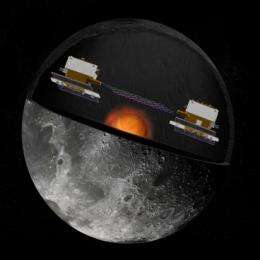To the moon: GRAIL lunar mission scheduled to launch

Today’s expected launch of NASA’s Gravity Recovery And Interior Laboratory (GRAIL) twin spacecraft, a carefully choreographed mission to precisely map the moon’s gravitational field, could help scientists understand fundamental questions about the moon’s composition, internal structure and evolution.
GRAIL’s principal investigator — Maria Zuber, the Earle A. Griswold Professor of Geophysics and Planetary Science at MIT — becomes not only the first MIT professor to lead a NASA mission, but also the first woman to lead a planetary spacecraft mission.
Following today’s launch of the twin GRAIL spacecraft and a four-month journey, GRAIL-A is scheduled to enter orbit around the moon Dec. 31; GRAIL-B will enter lunar orbit the following day. GRAIL’s 90-day scientific mapping mission will begin in March 2012.
“Technologically, it is blazing the trail for other planetary missions,” says Zuber, the head of MIT’s Department of Earth, Atmospheric and Planetary Sciences. “Using dual spacecraft in tight-formation flight, doing precise timing and gravity measurement, you could envision future planetary missions to Europa [one of Jupiter’s moons] to map currents in its subsurface ocean; to Venus to map the circulation of its atmosphere; and to Mars to observe the seasonal carbon dioxide cycle between its atmosphere and its surface.”
Analysis of data from the paired spacecraft will allow GRAIL to map the lunar gravitational field with unprecedented accuracy and resolution. The precise distance between the two spacecraft can be accurately measured using radio interferometry and tracking beacons with ultra-stable oscillators.
By precisely measuring changes in the distance between the twin orbiting spacecraft as they traverse the moon’s gravitational field, scientists expect to create a lunar gravity model up to 1,000 times more accurate than previous models. “The ability to calibrate observations in space and time brings a lot of value to scientific investigation,” Zuber says.
Dating back to the Apollo lunar program in the 1960s, the trajectories of unmanned orbiters circling the moon have been perturbed by its uneven gravitational field. These gravitational anomalies are believed to be caused primarily by subsurface geological features that could date back to the moon’s origin.
The detailed lunar-gravity model obtained from GRAIL will be compared to topographical models developed using the high-resolution laser altimeter on the Lunar Reconnaissance Orbiter (LRO) mission launched in 2009 — a project for which Zuber serves as the deputy principal investigator. “We have over four billion measurements of elevation on the moon from the LRO altimeter,” Zuber says, “so we will be correlating these two data sets. What we stand to learn in terms of crustal structure of the moon is really going to be unprecedented in planetary science.”
GRAIL’s close orbit — only 50 kilometers above the lunar surface — should permit better spatial resolution of the moon’s surface and subsurface geological features. “One of the science objectives is to understand the structure of impact basins and the role that impact basins played in the evolution of the moon,” Zuber says.
GRAIL is also the first mission to fly an imaging system that does not have a scientific objective: MoonKAM will be devoted entirely to education and outreach. This imaging system includes four cameras on each spacecraft that will be pointed at features on the lunar surface. Middle school students from around the world can request MoonKAM pictures of the lunar surface.
Former NASA astronaut Sally Ride, America’s first female astronaut, is leading GRAIL’s public outreach effort, which includes the development of an iPhone application that will allow students to follow the trajectory of the GRAIL spacecraft over the lunar surface. “Students are very interested in exploration,” Zuber says. “We hope they will share the thrill of discovery along with us.”
The GRAIL mission was selected as a NASA Discovery mission in 2007. Its scientific team includes researchers from NASA’s Goddard Space Flight Center, NASA’s Jet Propulsion Laboratory, the University of Arizona, the Southwest Research Institute and the University of Paris. MIT research scientist David Smith is GRAIL’s deputy principal investigator and Michael Watkins from the Jet Propulsion Laboratory is GRAIL’s project scientist.
Provided by Massachusetts Institute of Technology




















